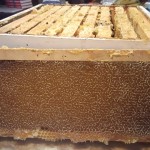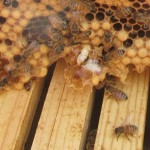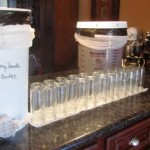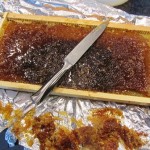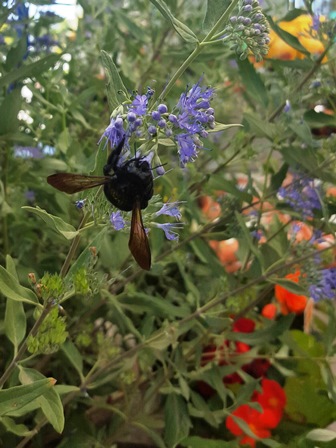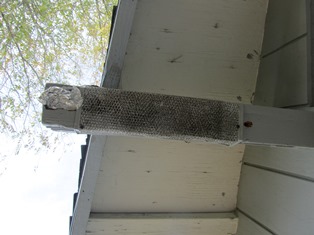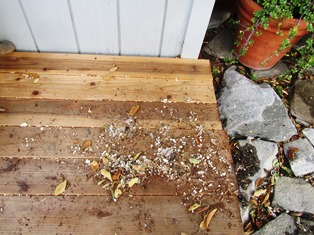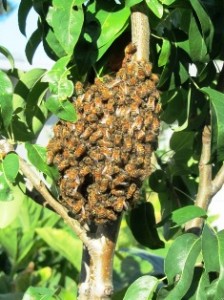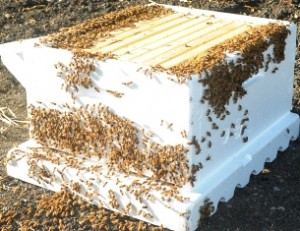Harvesting Honey–Helping Hands Always Welcome
When it comes to opening the hives of honey bees here on our farmette, I’m grateful for the helping hands of my hubby and my neighbor. Carlos, my hubby and helpmate for life, is my go-to guy for all our farm projects. And our neighbor Peter not only has answers to my questions about bees, but also he can open a hive, remove frames of honey, inspect and medicate, and seal the unit lickety-split.
With the smoker at the ready and lit, we opened our hives September 23, 2018. The hives were robust, but the bees appeared stressed. I had added supers to each hive in late July but should have kept a closer eye on the burgeoning bee population. They had become overcrowded and hungry.
For harvesting, we first removed the heavy metal lid of the hive box, replacing it with a fume board. A fume board is a lid lined with fabric that is sprayed with a product that encourages the bees to vacate the supers (some bees immediately leave the box; others go into the brood chambers). The fume board works within seven to ten minutes. We then pulled out the frames of honey, gently brushed off any remaining bees, and took the honey-heavy frames to the kitchen.
For an old hand at beekeeping like my neighbor, the process went quick. Not so for me. This past year, I injured both my shoulders with tears in the rotator cuff tendons. With limitation to some of my range of motion, I’ve felt pretty handicapped. Still, I helped by carrying a single frame of honey at a time from the hive box to the kitchen.
While the hives were open, we removed old medicated strips previously hung in the boxes to thwart mites.
- Small sheets for trapping hive beetles are placed across the frames in the top super before closing the lid
We also replaced the Bee-Gone sheets to trap hive beetles. It’s important to properly handle such items and to keep the apiary clean. We put in medication for mite control–a white gelatinous substance spread on a paper similiar to an index card. Finally, we placed a single patty of bee food on the frames to provide for the bees’ nutritional needs.
The bees immediately coalesced on the patty; no longer stressed, they seemed gentle and calm. Checking the bottom frames, we found a lot of brood (eggs, larvae and pupae of bees). To help this new generation of honey bees along, we inserted an unopened frame of honey that I’d kept wrapped in foil and frozen (freezing kills any insects that could infect the hive or bees). Honey, of course, is the perfect food for them.
We will reopen the hives in two weeks and re-check the status of the bees. A that time, we’ll treat with an antibiotic for winter and possibly add a super if necessary.
I haven’t yet processed the honey we harvested but the frames are on my kitchen counter. They are in a hive box wrapped in aluminum foil. At the ready are also several food-grade buckets that I’ve carefully washed, dried, and covered with lids. The honey spinning machine has been cleaned. Before I begin working with the honey in the frames, I always scrub my kitchen, washing the countertops twice–first with soap and water and then with diluted bleach and hot water.
When everything is clean, I will begin to work on each frame. I first scrape away any bee “glue” from the outside edges of the frame. With a hot knife, I slice all around the interior edges before opening the sealed wax cells (sliding the hot knife just under the wax and lifting). Both sides of the frame are dealt with in this manner. After the wax cells are uncapped, the frame will be placed into the spinning machine. It uses centrifugal force to spin off the honey. The sweet stuff then drains through the strainer material taped around the bucket mouth. The bucket is positioned under the machine spigot.
My reward for this labor of love is having an abundance of sweet, amber honey when desired to bake a honey cake or other culinary creation, to enjoy a relaxing cup of tea, or to fill jars for holiday gift-giving. Beekeeping draws people together and, take it from me, a helping hand is always appreciated.
_______________________________________________________________________________
If you enjoy reading about keeping bees and chickens, growing heirloom vegetables and fruits, or living the farmette (small farm) life, check out my offering of books that tie into themes of living well and close to the Earth.
Grab one or more of my cozy mysteries (no gratuitous sex, profanity, or violence) and discover delicious farm recipes, gardening advice, and tips for caring for bees and chickens.
Or pick up one of my wellness, spirituality, or manifesting books. They make great holiday gifts for yourself and others.
All my books are available in traditional bookstores everywhere and also online at Amazon.com, Barnes & Noble (barnesandnoble.com), Kobo Books, Walmart, and other retailers.
For more information, click on the following URLs:
A HIVE OF HOMICIDES
MURDER OF A QUEEN BEE
A BEELINE TO MURDER

More than 150 rituals for sound mind, strong body, and meaningful connections to the people around you
https://www.amazon.com/dp/B0719HHVRJ/ref=dp-kindle-redirect?_encoding=UTF8&btkr=1
Beauty in the Garden–Butterflies and Other Pollinators
I enjoyed studying botany and zoology in school, but never felt attracted to the study of butterflies, bees, beetles, and bugs with any kind of intensity. I regret that. Not only because some of these pollinators are beautiful, but many are also beneficial to gardens and orchards.
As a beekeeper, it’s my job to notice moths, hive beetles, and other flying and crawling insects. Though some are beautiful and beneficial, others can harm my honeybee hives. That’s why when walking around my garden, I pay attention to all sorts of creatures–whether winged or not.
I do love to see butterflies and Lady Beetles (also known as ladybugs, a beneficial garden insect) amid my flowers, bushes, and trees. Today, I spotted a lovely winged creature with black-and-white patterned wings and a blue body.
It stood out against the green leaves of plants in my bee garden and waited for me to run inside the house to get my cell phone camera.
I wonder if anyone can correctly identify this blue-body, black-and-white winged flier for me. Could this be an Arrowhead Blue butterfly? These, I know, are found in Northern California and the Sierras.
Another pollinator that “posed” for me earlier this year is the longhorn bee. It’s about the size of a bumble bee. Some of these fliers are so lovely, I could see spending hours taking pictures.
But chores and all the other farmette tasks take priority over photography. Still, I hope the pictures are clear enough for someone to identify the species when I can’t.
* * *
NEWLY RELEASED–The Murder of a Queen Bee (Kensington Publishing, NY–Sept. 2016).
Discover recipes, farming tips, and sayings as well as sort out a charming whodunnit. Click on the link under the picture.
See, http://tinyurl.com/h4kou4g
See, http://tinyurl.com/hxy3s8q
This debut novel launched the Henny Penny Farmette series of mysteries and sold out its first press run. It’s now available in mass market paperback and other formats.
Why We Should Love Toads
What is brown, relatively smooth-skinned, and burrows into dry soil in Western gardens? The answer is the Western spadefoot toad, and there are plenty of reasons to invite them them into making their home near yours.
They like to dine on cutworms, flies, grasshoppers, slugs, grubs, wood lice, and other small insects. In fact, a single spadefoot toad will eat roughly 10,000 to 20,000 insects a year. And that’s just from spring until fall, when they go into hibernation.
After eating all those insects, you’d think they might head for your vegetable patch or flowers. But no, they aren’t interested in harming your herbs, flowers, or veggies.
We can help these toads set up housing in our gardens by creating a shallow impression in the soil and placing a board or two over it, leaving just enough room for the toad to hop in. For an image and to hear the sound of the spadefoot toad, see: http://www.californiaherps.com/frogs/pages/s.hammondii.html
Like most living creatures, they need water. A water garden, pond, or even a ground-level plant saucer or bird bath will do the trick. An added benefit of a water garden or small pond is its attractiveness to toads to lay their eggs, ensuring generations of toads in your garden for years to come.
The Woodpecker Saga Continues
The woodpecker is back and apparently intent on taking down our roof strut. As I’ve mentioned in a previous blog, I believe it is a Nuttall’s Woodpecker (Picoides nuttallii) and possibly a female because of its small size and lack of red color on the back of the head and nape of the neck. The bird was named for naturalist Thomas Nuttal in 1843. It doesn’t eat acorns, yet its habitat is California oak woodlands.
After making two holes large enough to all but obscure the creature pecking away inside the beam, the woodpecker took off after I shooed him away. But despite me screwing in a screen to cover the two gaping holes, the woodpecker has created two new holes and has made a heck of a mess.
My husband and I awoke to the rat-ta-tat-tating before daylight. After a quick inspection of the woodpecker’s drilling, Carlos told me to stick aluminum foil into the hole until he could return from work today and either saw off the dead wood and reinforce the beam or figure out another solution.
In the mess on the porch floor beneath the roof beam are what appear to be remnants of a nest. Is it possible that the woodpecker once constructed a nest inside that roof beam? They nest in tree cavities, so it isn’t too far of a stretch from a tree to a strut. This industrious female might be trying to create a nest for mating season (January to March), preparing for egg laying in April and May. And interestingly, the male incubates the eggs at night while the female sits on them during the day for a total of about 14 days.
While the woodpecker pecks, I’ve resigned myself to staying in the kitchen, baking our pumpkin and pecan pies for Thanksgiving. All the while, I hear the tapping of a drumbeat as the woodpecker either forages for food (it likes insects and spiders and some berries) or creates a cavity for a nest.
Remind Me Again, What Good Are Gophers?

Cecile Brunner forms an arch over a statue of the Virgin Mary in one of the prettiest and most peaceful areas of my garden
The lovely Cecile Brunner rose that serves as the anchor for a small meditation garden on the northwest side of my little farmhouse suddenly appears yellowed, leafless, and lifeless. Honest to goodness, she looks like she’s croaked. It’s certainly a strange turn of events, since she had numerous new canes and the leaves were shiny and healthy only a week ago.
There is a small eruption of new dirt nearby–suggestive of moles (insect eaters) and gophers (vegetarians) and maybe voles–(voles eat roots but don’t leave mounds). So my rose problem might actually be two-fold–either way–it’s underground.
I could dig and back fill those tunnels with dirt and maybe I should. I’ve heard you can break a leg stepping into a gopher hole and I’m not talking livestock here. I wonder if the vole and gopher are sharing a network of tunnels down there dead-ending in the gopher’s bunker.
I gave the poor rose a big drink of water as soon as I discovered her condition, not knowing what else to do. As I stood there, watering with hose in hand, I saw the earth around the rose’s root cave in. Seriously?
So I’m thinking there must be a one heck of a big tunnel. This is war! I decide to stick the hose right into the tunnel and fill it with as much water as that hole will hold . . . and then some.
Strangely, while I’m dealing with the rose problem, I look past the fresh dirt mound and notice that one of the Dutch purple irises in a bed of a hundred or more has broken into full bloom. What gives? Those beauties normally bloom around Easter. I wonder why the voles haven’t attacked the rhizomes of the irises.
The condition of the Cecile Brunner climbing rose breaks my heart. Maybe she’ll spring back to life to bloom again next spring. For now, I’ll clip the beautiful iris and tuck it into a vase with some roses from other bushes on the farmette. That done, I’ll put an all-out effort into finding out how to get rid of those underground buck-tooth bandits . . . for good. Feel free to leave me your ideas. I’ve tried almost everything I’ve read on the Internet.
Protecting Honeybee Hives
In early October, I helped my beekeeper neighbor medicate his honeybees as well as the bees in the hives he had given me. Our work will ensure the bees make it through the winter. Although some beekeepers do not believe much in the value of medicating bees to ensure the health of the colony, my neighbor (who learned beekeeping at the knee of his father) maintains a healthy colony of bees that are flourishing and producing large quantities of honey.
Healthy bees are necessary for pollination of our nation’s crops. For reasons not well understood, roughly one-third of all the U.S. honeybee colonies have disappeared since 2006 when beekeepers in America and Europe sounded the alarm that worker bees were not returning to their hives and disappearing at alarming rates. Initially beekeepers and scientists postulated that the honeybee problem could be traced to infection by mites, a fungus, a weakened immune system, contact with pesticides, and/or stress or combinations of several factors. More recently, studies are suggesting that the CCD problem possibly is related to the use of neonicotinoids, a new class of pesticides introduced in the 1990s.
Chemically linked to nicotine, neonicotinoids are associated with diminishing bee populations in several new studies, although the Agriculture Research Service (ARS), the internal research agency of the U.S. Department of Agriculture, asserts that little is known about the causes of CCD. The ARS offers the following advice to beekeepers: “mitigation must be based on improving general honey bee health and habitat and countering known mortality factors by using best management practices. This includes supplemental feeding in times of nectar/pollen scarcity.” See, http://www.ars.usda.gov/News/docs.htm?docid=15572#bk
Commercial beekeepers feed their bees corn syrup and neonicotinoids have been used routinely on corn. Recently, Harvard Professor Chensheng Lu was quoted in a New Yorker article as stating he believes one reason for CCD is the “link between high-fructose corn syrup and use of neonicotinoids.”
So while my neighbor and I can medicate against pathogens and parasites, we will be watching to see what the EPA, the USDA, and other governmental agencies decide about the widespread use of pesticides and specifically the use of neonicotinoids.
 Facebook
Facebook Goodreads
Goodreads LinkedIn
LinkedIn Meera Lester
Meera Lester Twitter
Twitter




